The Influence of Ocean Processes on Fine-Scale Changes in the Yellow Sea Cold Water Mass Boundary Area Structure Based on Acoustic Observations
Abstract
:1. Introduction
2. Materials and Methods
2.1. Survey Information
2.2. Date Collection
2.3. Acoustic Data Analysis
3. Results
3.1. Overview of Cruises in 2021 and 2022
3.2. Characteristics of DVM in Summer in the YS
3.3. Hydrological Structure of the YS Based on Acoustic Remote Sensing
3.4. Fine-Scale Variation in the YSCWM Water Structure
4. Discussion
4.1. The DVM of Zooplankton in Summer in the YS
4.2. The Potential Utilization of Acoustic Remote Sensing on Reflecting High-Resolution Ocean Structures
4.3. Mechanisms of the Influence of Key Ocean Processes on the YSCWM Structure
4.4. YS Boundary Area Hydrodynamic–Hydrologic–Ecological Variation Pattern
5. Conclusions
- (1)
- We observed significant high-frequency thermocline fluctuations at the YSCWM boundary; zooplankton were below the thermocline during the day and migrated above it at night;
- (2)
- Through the ground-truthing of CTD, the YS summer thermocline can be successfully detected using acoustic remote sensing;
- (3)
- Shear caused by internal waves and flood tides negatively weaken the stratification of the water column, which is more pronounced when the two mechanisms are concurrent (weakening of the thermocline by 0.5 °C/m); ebb tides have a positive effect on water column stratification. In the area of tidal fronts, tide-induced upwelling can also cause significant fluctuations in isotherms.
Author Contributions
Funding
Data Availability Statement
Acknowledgments
Conflicts of Interest
References
- Lue, X.; Qiao, F.; Xia, C.; Wang, G.; Yuan, Y. Upwelling and surface cold patches in the Yellow Sea in summer: Effects of tidal mixing on the vertical circulation. Cont. Shelf Res. 2010, 30, 620–632. [Google Scholar] [CrossRef]
- Oh, K.-H.; Lee, S.; Song, K.-M.; Lie, H.-J.; Kim, Y.-T. The temporal and spatial variability of the Yellow Sea Cold Water Mass in the southeastern Yellow Sea, 2009-2011. Acta Oceanol. Sin. 2013, 32, 1–10. [Google Scholar] [CrossRef]
- Ge, R.; Chen, H.; Liu, G.; Zhu, Y.; Jiang, Q. Diel vertical migration of mesozooplankton in the northern Yellow Sea. J. Oceanol. Limnol. 2021, 39, 1373–1386. [Google Scholar] [CrossRef]
- Li, M.; Zhong, L. Flood-ebb and spring-neap variations of mixing, stratification and circulation in Chesapeake Bay. Cont. Shelf Res. 2009, 29, 4–14. [Google Scholar] [CrossRef]
- Chu, P.C.; Fralick, C.R.; Haeger, S.D.; Carron, M.J. A parametric model for the Yellow Sea thermal variability. J. Geophys. Res. Ocean. 1997, 102, 10499–10507. [Google Scholar] [CrossRef]
- Qiao, F.; Ma, J.; Xia, C.; Yang, Y.; Yuan, Y. Influences of the surface wave-induced mixing and tidal mixing on the vertical temperature structure of the Yellow and East China Seas in summer. Prog. Nat. Sci. 2006, 16, 739–746. [Google Scholar] [CrossRef]
- Park, S.; Chu, P.C. Synoptic distributions of thermal surface mixed layer and thermocline in the southern Yellow and East China Seas. J. Oceanogr. 2007, 63, 1021–1028. [Google Scholar] [CrossRef]
- Li, J.; Jiang, F.; Wu, R.; Zhang, C.; Tian, Y.; Sun, P.; Yu, H.; Liu, Y.; Ye, Z.; Ma, S.; et al. Tidally Induced Temporal Variations in Growth of Young-of-the-Year Pacific Cod in the Yellow Sea. J. Geophys. Res. Ocean. 2021, 126, 6696. [Google Scholar] [CrossRef]
- Liu, K.; Sun, J.; Guo, C.; Yang, Y.; Yu, W.; Wei, Z. Seasonal and Spatial Variations of the M-2 Internal Tide in the Yellow Sea. J. Geophys. Res. Ocean. 2019, 124, 1115–1138. [Google Scholar] [CrossRef]
- Liu, Z.; Wei, H.; Lozovatsky, I.D.; Fernando, H.J.S. Late summer stratification, internal waves, and turbulence in the Yellow Sea. J. Mar. Syst. 2009, 77, 459–472. [Google Scholar] [CrossRef]
- Xu, P.; Yang, W.; Zhu, B.; Wei, H.; Zhao, L.; Nie, H. Turbulent mixing and vertical nitrate flux induced by the semidiurnal internal tides in the southern Yellow Sea. Cont. Shelf Res. 2020, 208, 104240. [Google Scholar] [CrossRef]
- Li, J.; Li, G.; Xu, J.; Dong, P.; Qiao, L.; Liu, S.; Sun, P.; Fan, Z. Seasonal evolution of the Yellow Sea Cold Water Mass and its interactions with ambient hydrodynamic system. J. Geophys. Res. Ocean. 2016, 121, 6779–6792. [Google Scholar] [CrossRef]
- Huang, M.; Liang, X.S.; Wu, H.; Wang, Y. Different Generating Mechanisms for the Summer Surface Cold Patches in the Yellow Sea. Atmos. Ocean. 2018, 56, 199–211. [Google Scholar] [CrossRef]
- Wang, B.; Wu, L.; Zhao, N.; Liu, T.; Hirose, N. Summer Wind Effects on Coastal Upwelling in the Southwestern Yellow Sea. J. Mar. Sci. Eng. 2021, 9, 1021. [Google Scholar] [CrossRef]
- Meng, Q.; Li, P.; Zhai, F.; Gu, Y. The vertical mixing induced by winds and tides over the Yellow Sea in summer: A numerical study in 2012. Ocean. Dyn. 2020, 70, 847–861. [Google Scholar] [CrossRef]
- Ren, S.; Xie, J.; Zhu, J. The Roles of Different Mechanisms Related to the Tide-induced Fronts in the Yellow Sea in Summer. Adv. Atmos. Sci. 2014, 31, 1079–1089. [Google Scholar] [CrossRef]
- Holliday, D.V.; Pieper, R.E. Bioacoustical Oceanography At High-Frequencies. Ices J. Mar. Sci. 1995, 52, 279–296. [Google Scholar] [CrossRef]
- Cisewski, B.; Strass, V.H.; Rhein, M.; Kraegefsky, S. Seasonal variation of diel vertical migration of zooplankton from ADCP backscatter time series data in the Lazarev Sea, Antarctica. Deep. Sea Res. Part I-Oceanogr. Res. Pap. 2010, 57, 78–94. [Google Scholar] [CrossRef]
- Diaz-Astudillo, M.; Caceres, M.A.; Landaeta, M.F. Zooplankton structure and vertical migration: Using acoustics and biomass to compare stratified and mixed fjord systems. Cont. Shelf Res. 2017, 148, 208–218. [Google Scholar] [CrossRef]
- Brierley, A.S.; Brandon, M.A.; Watkins, J.L. An assessment of the utility of an acoustic Doppler current profiler for biomass estimation. Deep. Sea Res. Part I-Oceanogr. Res. Pap. 1998, 45, 1555–1573. [Google Scholar] [CrossRef]
- Valle-Levinson, A.; Castro, L.; Caceres, M.; Pizarro, O. Twilight vertical migrations of zooplankton in a Chilean fjord. Prog. Oceanogr. 2014, 129, 114–124. [Google Scholar] [CrossRef]
- Escobar-Flores, P.C.; Ladroit, Y.; O’Driscoll, R.L. Acoustic Assessment of the Micronekton Community on the Chatham Rise, New Zealand, Using a Semi-Automated Approach. Front. Mar. Sci. 2019, 6, 507. [Google Scholar] [CrossRef]
- Perelman, J.N.; Ladroit, Y.; Escobar-Flores, P.; Firing, E.; Drazen, J.C. Eddies and fronts influence pelagic communities across the eastern Pacific ocean. Prog. Oceanogr. 2023, 211, 102967. [Google Scholar] [CrossRef]
- Kim, H.; Kim, G.; Kim, M.; Kang, D. Spatial Distribution of Sound Scattering Layer and Density Estimation of Euphausia pacifica in the Center of the Yellow Sea Bottom Cold Water Determined by Hydroacoustic Surveying. J. Mar. Sci. Eng. 2022, 10, 10056. [Google Scholar] [CrossRef]
- Aparna, S.G.; Desai, D.V.; Shankar, D.; Anil, A.C.; Dora, S.; Khedekar, R. Seasonal cycle of zooplankton standing stock inferred from ADCP backscatter measurements in the eastern Arabian Sea. Prog. Oceanogr. 2022, 203, 102766. [Google Scholar] [CrossRef]
- Dwinovantyo, A.; Manik, H.M.; Prartono, T.; Susilohadi, S.; Mukai, T. Variation of Zooplankton Mean Volume Backscattering Strength from Moored and Mobile ADCP Instruments for Diel Vertical Migration Observation. Appl. Sci. 2019, 9, 1851. [Google Scholar] [CrossRef]
- Song, Y.; Yang, J.; Wang, C.; Sun, D. Spatial patterns and environmental associations of deep scattering layers in the northwestern subtropical Pacific Ocean. Acta Oceanol. Sin. 2022, 41, 139–152. [Google Scholar] [CrossRef]
- Liu, Y.; Guo, J.; Xue, Y.; Sangmanee, C.; Wang, H.; Zhao, C.; Khokiattiwong, S.; Yu, W. Seasonal variation in diel vertical migration of zooplankton and micronekton in the Andaman Sea observed by a moored ADCP. Deep. Sea Res. Part I-Oceanogr. Res. Pap. 2022, 179, 103663. [Google Scholar] [CrossRef]
- Lee, H.; Cho, S.; Kim, W.; Kang, D. The diel vertical migration of the sound-scattering layer in the Yellow Sea Bottom Cold Water of the southeastern Yellow sea: Focus on its relationship with a temperature structure. Acta Oceanol. Sin. 2013, 32, 44–49. [Google Scholar] [CrossRef]
- Ker, S.; Le Gonidec, Y.; Marie, L. Multifrequency seismic detectability of seasonal thermoclines assessed from ARGO data. J. Geophys. Res. Ocean. 2016, 121, 6035–6060. [Google Scholar] [CrossRef]
- Stranne, C.; Mayer, L.; Jakobsson, M.; Weidner, E.; Jerram, K.; Weber, T.C.; Anderson, L.G.; Nilsson, J.; Bjork, G.; Gardfeldt, K. Acoustic mapping of mixed layer depth. Ocean Sci. 2018, 14, 503–514. [Google Scholar] [CrossRef]
- Grados, D.; Bertrand, A.; Colas, F.; Echevin, V.; Chaigneau, A.; Gutierrez, D.; Vargas, G.; Fablet, R. Spatial and seasonal patterns of fine-scale to mesoscale upper ocean dynamics in an Eastern Boundary Current System. Prog. Oceanogr. 2016, 142, 105–116. [Google Scholar] [CrossRef]
- Bertrand, A.; Ballon, M.; Chaigneau, A. Acoustic Observation of Living Organisms Reveals the Upper Limit of the Oxygen Minimum Zone. PLoS ONE 2010, 5, e1033. [Google Scholar] [CrossRef] [PubMed]
- Fer, I.; Nandi, P.; Holbrook, W.S.; Schmitt, R.W.; Paramo, P. Seismic imaging of a thermohaline staircase in the western tropical North Atlantic. Ocean Sci. 2010, 6, 621–631. [Google Scholar] [CrossRef]
- Stranne, C.; Mayer, L.; Weber, T.C.; Ruddick, B.R.; Jakobsson, M.; Jerram, K.; Weidner, E.; Nilsson, J.; Gardfeldt, K. Acoustic Mapping of Thermohaline Staircases in the Arctic Ocean. Sci. Rep. 2017, 7, 15192. [Google Scholar] [CrossRef]
- Koterayama, W.; Yamaguchi, S.; Yokobiki, T.; Yoon, J.H.; Hase, H. Space-continuous measurements on ocean current and chemical properties with the intelligent towed vehicle “Flying Fish”. IEEE J. Ocean. Eng. 2000, 25, 130–138. [Google Scholar] [CrossRef]
- Moum, J.N.; Farmer, D.M.; Smyth, W.D.; Armi, L.; Vagle, S. Structure and generation of turbulence at interfaces strained by internal solitary waves propagating shoreward over the continental shelf. J. Phys. Oceanogr. 2003, 33, 2093–2112. [Google Scholar] [CrossRef]
- Lavery, A.C.; Schmitt, R.W.; Stanton, T.K. High-frequency acoustic scattering from turbulent oceanic microstructure: The importance of density fluctuations. J. Acoust. Soc. Am. 2003, 114, 2685–2697. [Google Scholar] [CrossRef]
- Feng, Y.; Tang, Q.; Li, J.; Sun, J.; Zhan, W. Internal Solitary Waves Observed on the Continental Shelf in the Northern South China Sea From Acoustic Backscatter Data. Front. Mar. Sci. 2021, 8, 734075. [Google Scholar] [CrossRef]
- Bertrand, A.; Grados, D.; Colas, F.; Bertrand, S.; Capet, X.; Chaigneau, A.; Vargas, G.; Mousseigne, A.; Fablet, R. Broad impacts of fine-scale dynamics on seascape structure from zooplankton to seabirds. Nat. Commun. 2014, 5, 6239. [Google Scholar] [CrossRef]
- Lennert-Cody, C.E.; Franks, P.J.S. Plankton patchiness in high-frequency internal waves. Mar. Ecol. Prog. Ser. 1999, 186, 59–66. [Google Scholar] [CrossRef]
- Embling, C.B.; Sharples, J.; Armstrong, E.; Palmer, M.R.; Scott, B.E. Fish behaviour in response to tidal variability and internal waves over a shelf sea bank. Prog. Oceanogr. 2013, 117, 106–117. [Google Scholar] [CrossRef]
- Ladroit, Y.; Escobar-Flores, P.C.; Schimel, A.C.; O’Driscoll, R.L. ESP3: An open-source software for the quantitative processing of hydro-acoustic data. Softwarex 2020, 12, 100581. [Google Scholar] [CrossRef]
- De Robertis, A.; Higginbottom, I. A post-processing technique to estimate the signal-to-noise ratio and remove echosounder background noise. Ices J. Mar. Sci. 2007, 64, 1282–1291. [Google Scholar] [CrossRef]
- Iida, K.; Mukai, T.; Hwang, D.J. Relationship between acoustic backscattering strength and density of zooplankton in the sound-scattering layer. Ices J. Mar. Sci. 1996, 53, 507–512. [Google Scholar] [CrossRef]
- MacLennan, D.N.; Fernandes, P.G.; Dalen, J. A consistent approach to definitions and symbols in fisheries acoustics. Ices J. Mar. Sci. 2002, 59, 365–369. [Google Scholar] [CrossRef]
- Yang, C.; Xu, D.; Chen, Z.; Wang, J.; Xu, M.; Yuan, Y.; Zhou, M. Diel vertical migration of zooplankton and micronekton on the northern slope of the South China Sea observed by a moored ADCP. Deep. Sea Res. Part II-Top. Stud. Oceanogr. 2019, 167, 93–104. [Google Scholar] [CrossRef]
- Ursella, L.; Pensieri, S.; Pallas-Sanz, E.; Herzka, S.Z.; Bozzano, R.; Tenreiro, M.; Cardin, V.; Candela, J.; Sheinbaum, J. Diel, lunar and seasonal vertical migration in the deep western Gulf of Mexico evidenced from a long-term data series of acoustic backscatter. Prog. Oceanogr. 2021, 195, 102562. [Google Scholar] [CrossRef]
- Gartner, J.W. Estimating suspended solids concentrations from backscatter intensity measured by acoustic Doppler current profiler in San Francisco Bay, California. Mar. Geol. 2004, 211, 169–187. [Google Scholar] [CrossRef]
- Assunção, R.V.; Lebourges-Dhaussy, A.; Da Silva, A.C.; Bourlès, B.; Vargas, G.; Roudaut, G.; Bertrand, A. On the use of acoustic data to characterise the thermohaline stratification in a tropical ocean. Ocean. Sci. Discuss. 2021, 1–20, in press. [Google Scholar]
- Black, W.J.; Dickey, T.D. Observations and analyses of upper ocean responses to tropical storms and hurricanes in the vicinity of Bermuda. J. Geophys. Res. Ocean. 2008, 113, 4358. [Google Scholar] [CrossRef]
- Simpson, J.H.; Hunter, J.R. Fronts in the Irish Sea. Nature 1974, 250, 404–406. [Google Scholar] [CrossRef]
- Zhao, B.R. A preliminary study of continental shelf fronts in the western part of southern Huanghai Sea and circulation structure in the front region of the Huanghai Cold Water Mass (HCWM). Oceanol. Et Limnol. Sin. 1987, 18, 217–226. [Google Scholar]
- Thygesen, U.H.; Patterson, T.A. Oceanic diel vertical migrations arising from a predator-prey game. Theor. Ecol. 2019, 12, 17–29. [Google Scholar] [CrossRef]
- Hays, G.C. A review of the adaptive significance and ecosystem consequences of zooplankton diel vertical migrations. Hydrobiologia 2003, 503, 163–170. [Google Scholar] [CrossRef]
- Heywood, K.J. Diet vertical migration of zooplankton in the Northeast Atlantic. J. Plankton Res. 1996, 18, 163–184. [Google Scholar] [CrossRef]
- Lu, L.-G.; Liu, J.; Yu, F.; Wu, W.; Yang, X. Vertical Migration of Sound Scatterers in the Southern Yellow Sea in Summer. Ocean Sci. J. 2007, 42, 1–8. [Google Scholar] [CrossRef]
- Bianchi, D.; Mislan, K.A.S. Global patterns of diel vertical migration times and velocities from acoustic data. Limnol. Oceanogr. 2016, 61, 353–364. [Google Scholar] [CrossRef]
- Li, Y.; Ge, R.; Chen, H.; Zhuang, Y.; Liu, G.; Zheng, Z. Functional diversity and groups of crustacean zooplankton in the southern Yellow Sea. Ecol. Indic. 2022, 136, 108699. [Google Scholar] [CrossRef]
- Zuo, T.; Wang, R.; Wang, K.; Gao, S. Vertical distribution and diurnal migration of zooplankton in the southern Yellow Sea in summer. Acta Ecol. Sin. 2004, 24, 524–530. [Google Scholar]
- Zhou, K.; Sun, S.; Wang, M.; Wang, S.; Li, C. Differences in the physiological processes of Calanus sinicus inside and outside the Yellow Sea Cold Water Mass. J. Plankton Res. 2016, 38, 551–563. [Google Scholar] [CrossRef]
- Liu, X.; Huang, B.; Liu, Z.; Wang, L.; Wei, H.; Li, C.; Huang, Q. High-resolution phytoplankton diel variations in the summer stratified central Yellow Sea. J. Oceanogr. 2012, 68, 913–927. [Google Scholar] [CrossRef]
- Yi, X.; Huang, Y.; Zhuang, Y.; Chen, H.; Yang, F.; Wang, W.; Xu, D.; Liu, G.; Zhang, H. In situ diet of the copepod Calanus sinicus in coastal waters of the South Yellow Sea and the Bohai Sea. Acta Oceanol. Sin. 2017, 36, 68–79. [Google Scholar] [CrossRef]
- Bao, Q.; Hui, S.; Wang, H. Sound scattering expriment of the thermocline in shallow sea. Acta Acust. 1994, 19, 402–407. [Google Scholar]
- Font, J.; Boutin, J.; Reul, N.; Spurgeon, P.; Ballabrera-Poy, J.; Chuprin, A.; Gabarro, C.; Gourrion, J.; Guimbard, S.; Henocq, C.; et al. SMOS first data analysis for sea surface salinity determination. Int. J. Remote Sens. 2013, 34, 3654–3670. [Google Scholar] [CrossRef]
- Durand, F.; Gourdeau, L.; Delcroix, T.; Verron, J. Can we improve the representation of modeled ocean mixed layer by assimilating surface-only satellite-derived data? A case study for the tropical Pacific during the 1997–1998 El Nino. J. Geophys. Res. Ocean. 2003, 108, 1603. [Google Scholar] [CrossRef]
- Xia, L.; Liu, H.; Lin, L.; Wang, Y. Surface Chlorophyll-A Fronts in the Yellow and Bohai Seas Based on Satellite Data. J. Mar. Sci. Eng. 2021, 9, 1301. [Google Scholar] [CrossRef]
- Jay, D.A.; Smith, J.D. Residual Circulation in Shallow Estuaries. 1. Highly Stratified, Narrow Estuaries. J. Geophys. Res. Ocean. 1990, 95, 711–731. [Google Scholar] [CrossRef]
- Simpson, J.H.; Brown, J.; Matthews, J.; Allen, G. Tidal Straining, Density Currents, And Stirring in the Control of Estuarine Stratification. Estuaries 1990, 13, 125–132. [Google Scholar] [CrossRef]
- Li, M.; Radhakrishnan, S.; Piomelli, U.; Geyer, W.R. Large-eddy simulation of the tidal-cycle variations of an estuarine boundary layer. J. Geophys. Res. Ocean. 2010, 115, 5702. [Google Scholar] [CrossRef]
- Rippeth, T.P.; Palmer, M.R.; Simpson, J.H.; Fisher, N.R.; Sharples, J. Thermocline mixing in summer stratified continental shelf seas. Geophys. Res. Lett. 2005, 32, 22104. [Google Scholar] [CrossRef]
- Zhao, Z.; Liu, B.; Li, X. Internal solitary waves in the China seas observed using satellite remote-sensing techniques: A review and perspectives. Int. J. Remote Sens. 2014, 35, 3926–3946. [Google Scholar] [CrossRef]
- Lavery, A.C.; Chu, D.; Moum, J.N. Measurements of acoustic scattering from zooplankton and oceanic microstructure using a broadband echosounder. Ices J. Mar. Sci. 2010, 67, 379–394. [Google Scholar] [CrossRef]
- Guo, J.; Yuan, H.; Song, J.; Li, X.; Duan, L. Hypoxia, acidification and nutrient accumulation in the Yellow Sea Cold Water of the South Yellow Sea. Sci. Total Environ. 2020, 745, 141050. [Google Scholar] [CrossRef] [PubMed]
- Zhai, W. Exploring seasonal acidification in the Yellow Sea. Sci. China Earth Sci. 2018, 61, 647–658. [Google Scholar] [CrossRef]
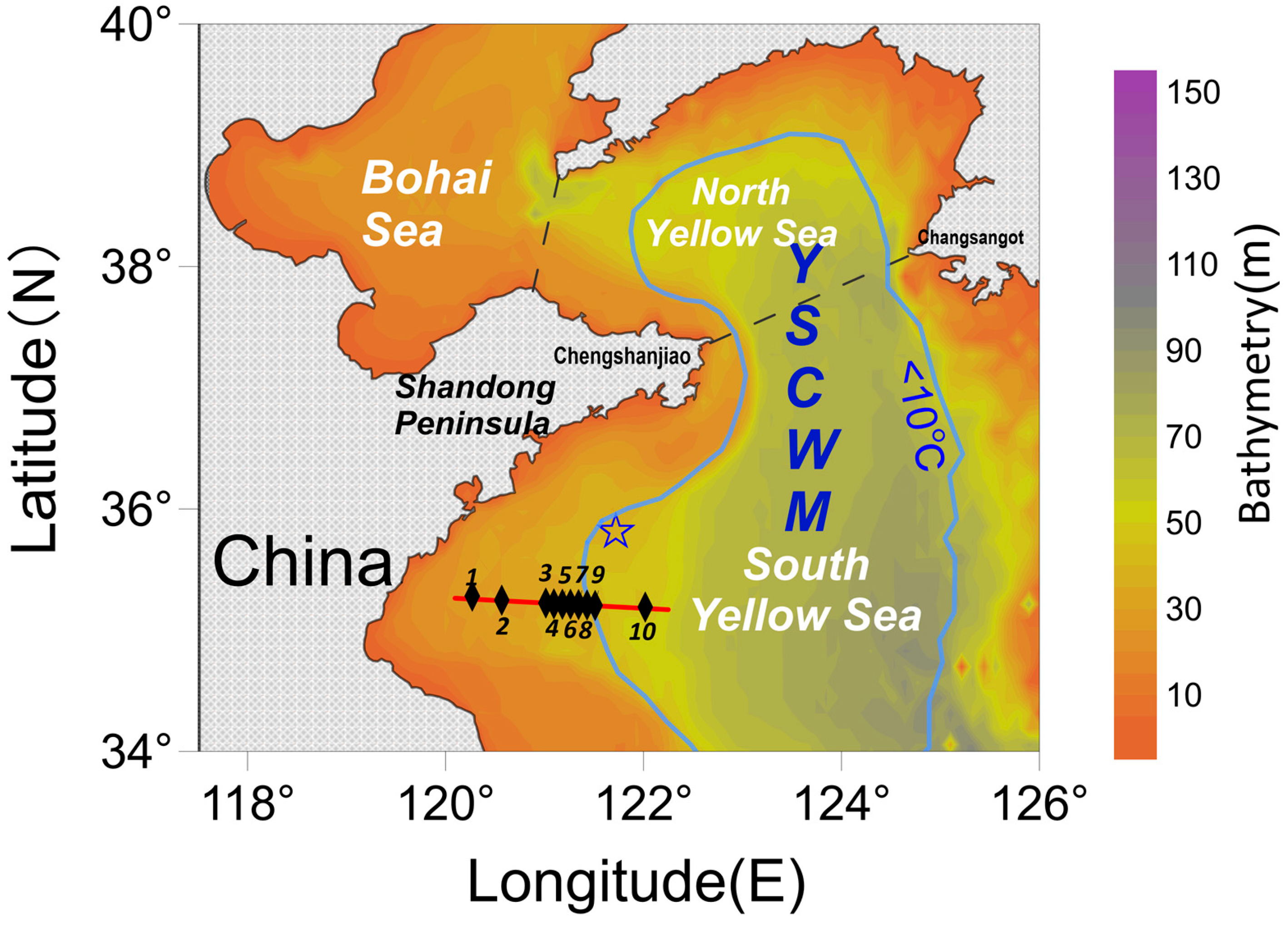

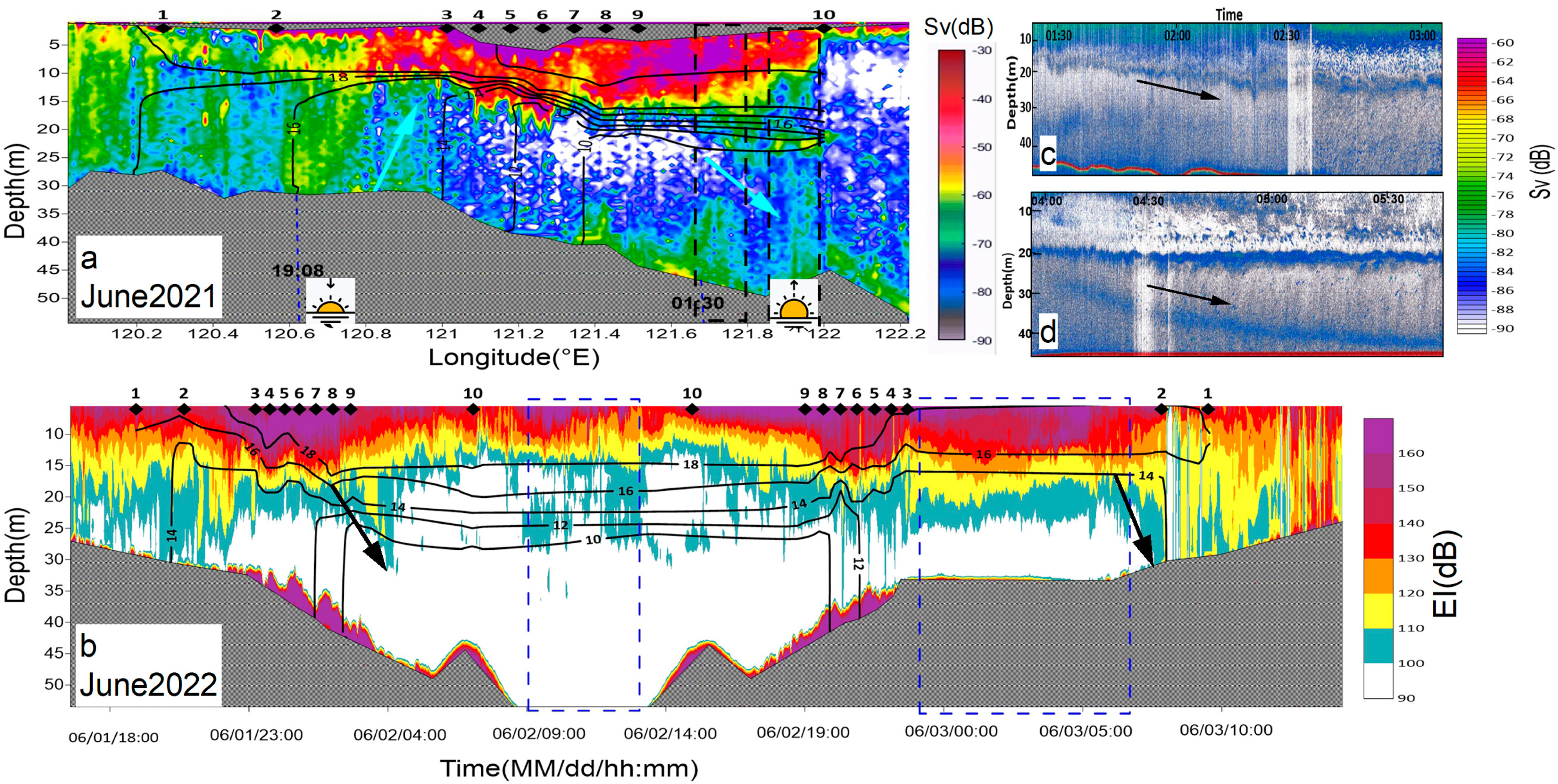


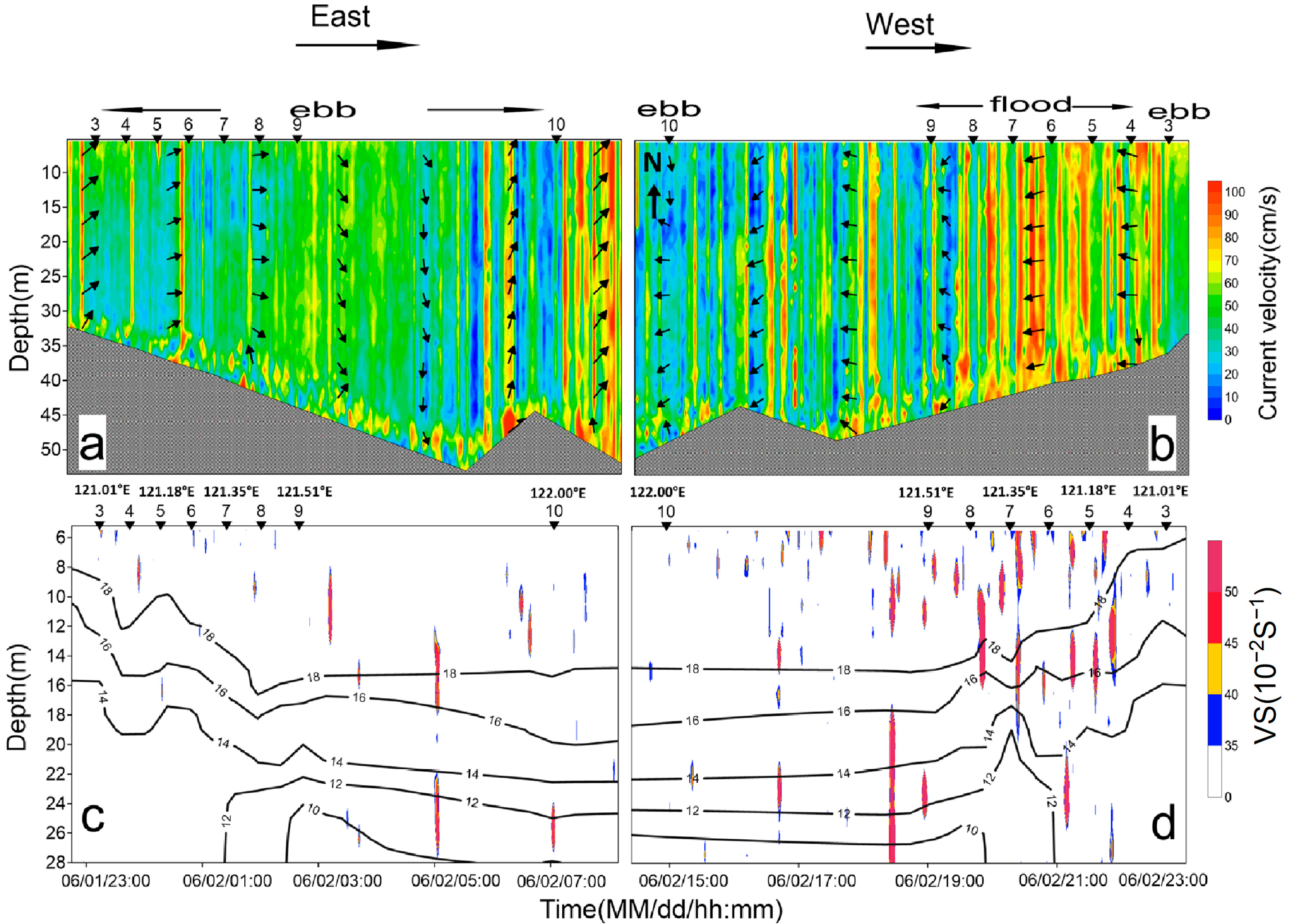
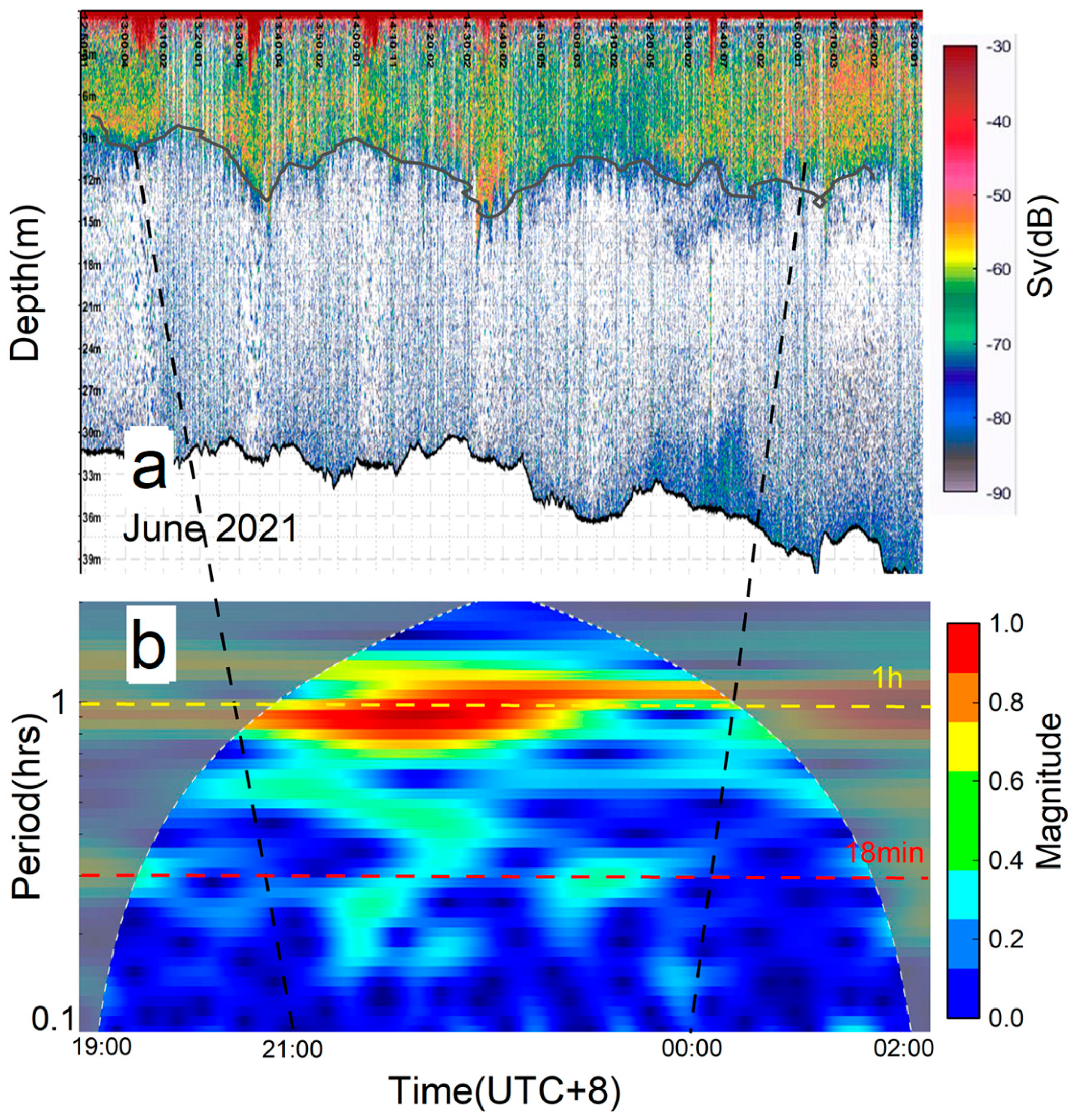
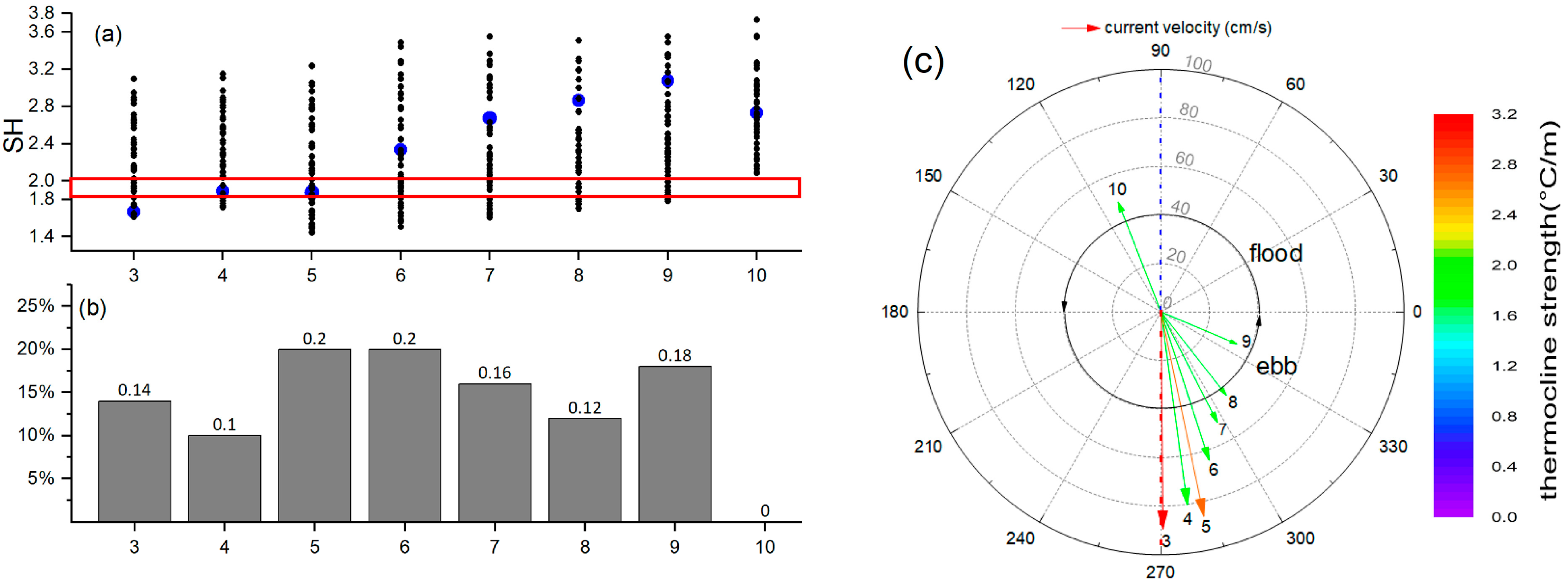
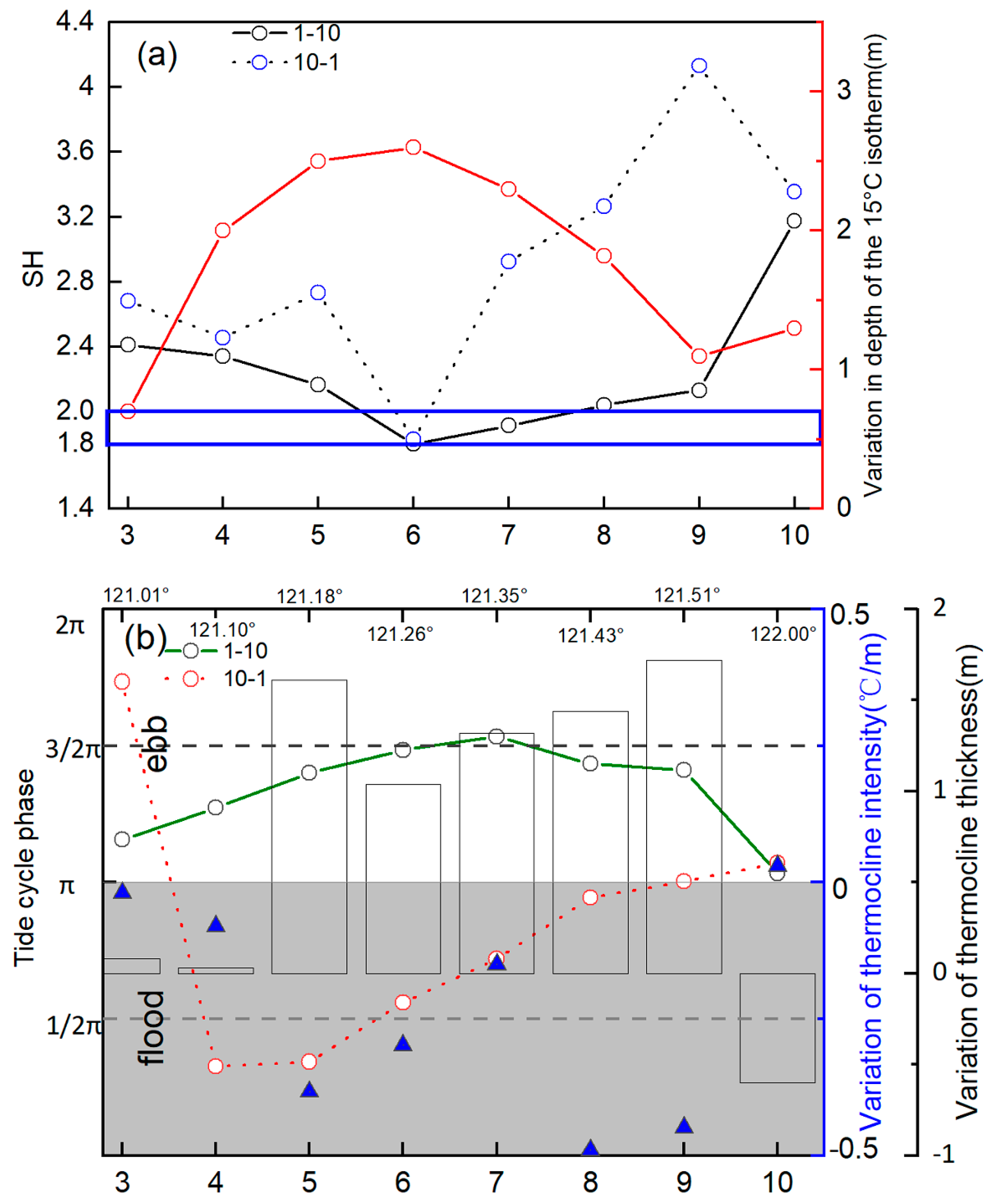
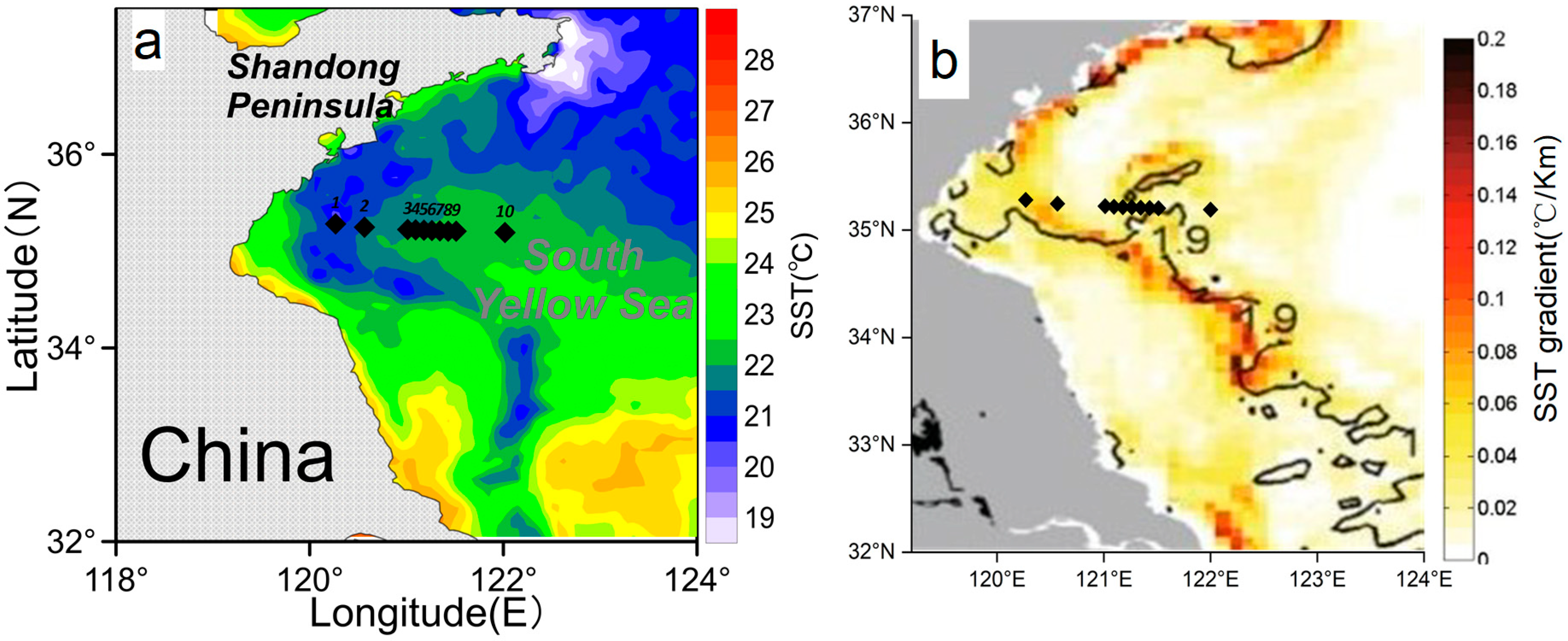

| Start (UTC + 8) | End (UTC + 8) | Acoustic Equipment |
|---|---|---|
| 24 June 2021 14:30 | 25 June 2021 07:30 | EK80 (120 kHz) |
| 1 June 2022 16:30 | 2 June 2022 13:00 | ADCP (300 kHz) |
| 2 June 2022 13:00 | 3 June 2022 14:30 |
| Stations | 2021 Cruise Times (UTC + 8) | 2022 Cruise Times | Latitude (N) | Longitude (E) | |
|---|---|---|---|---|---|
| Start | Return | ||||
| 1 | 24 June 18:15 | 1 June 18:56 | 3 June 09:29 | 35.28° | 120.27° |
| 2 | 24 June 21:00 | 1 June 20:41 | 3 June 07:51 | 35.25° | 120.57° |
| 3 | 24 June 21:36 | 1 June 23:14 | 2 June 22:42 | 35.22° | 121.01° |
| 4 | 24 June 22:00 | 1 June 23:46 | 2 June 22:06 | 35.22° | 121.10° |
| 5 | 24 June 22:31 | 2 June 00:18 | 2 June 21:29 | 35.21° | 121.18° |
| 6 | 24 June 23:00 | 2 June 00:51 | 2 June 20:52 | 35.21° | 121.26° |
| 7 | 24 June 23:32 | 2 June 01:25 | 2 June 20:16 | 35.21° | 121.35° |
| 8 | 25 June 00:01 | 2 June 02:03 | 2 June 19:38 | 35.21° | 121.43° |
| 9 | 25 June 00:30 | 2 June 02:41 | 2 June 18:57 | 35.20° | 121.51° |
| 10 | 25 June 05:00 | 2 June 07:07 | 2 June 14:57 | 35.19° | 122.00° |
Disclaimer/Publisher’s Note: The statements, opinions and data contained in all publications are solely those of the individual author(s) and contributor(s) and not of MDPI and/or the editor(s). MDPI and/or the editor(s) disclaim responsibility for any injury to people or property resulting from any ideas, methods, instructions or products referred to in the content. |
© 2023 by the authors. Licensee MDPI, Basel, Switzerland. This article is an open access article distributed under the terms and conditions of the Creative Commons Attribution (CC BY) license (https://creativecommons.org/licenses/by/4.0/).
Share and Cite
Nie, L.; Li, J.; Wu, H.; Zhang, W.; Tian, Y.; Liu, Y.; Sun, P.; Ye, Z.; Ma, S.; Gao, Q. The Influence of Ocean Processes on Fine-Scale Changes in the Yellow Sea Cold Water Mass Boundary Area Structure Based on Acoustic Observations. Remote Sens. 2023, 15, 4272. https://doi.org/10.3390/rs15174272
Nie L, Li J, Wu H, Zhang W, Tian Y, Liu Y, Sun P, Ye Z, Ma S, Gao Q. The Influence of Ocean Processes on Fine-Scale Changes in the Yellow Sea Cold Water Mass Boundary Area Structure Based on Acoustic Observations. Remote Sensing. 2023; 15(17):4272. https://doi.org/10.3390/rs15174272
Chicago/Turabian StyleNie, Lingyun, Jianchao Li, Hao Wu, Wenchao Zhang, Yongjun Tian, Yang Liu, Peng Sun, Zhenjiang Ye, Shuyang Ma, and Qinfeng Gao. 2023. "The Influence of Ocean Processes on Fine-Scale Changes in the Yellow Sea Cold Water Mass Boundary Area Structure Based on Acoustic Observations" Remote Sensing 15, no. 17: 4272. https://doi.org/10.3390/rs15174272
APA StyleNie, L., Li, J., Wu, H., Zhang, W., Tian, Y., Liu, Y., Sun, P., Ye, Z., Ma, S., & Gao, Q. (2023). The Influence of Ocean Processes on Fine-Scale Changes in the Yellow Sea Cold Water Mass Boundary Area Structure Based on Acoustic Observations. Remote Sensing, 15(17), 4272. https://doi.org/10.3390/rs15174272







